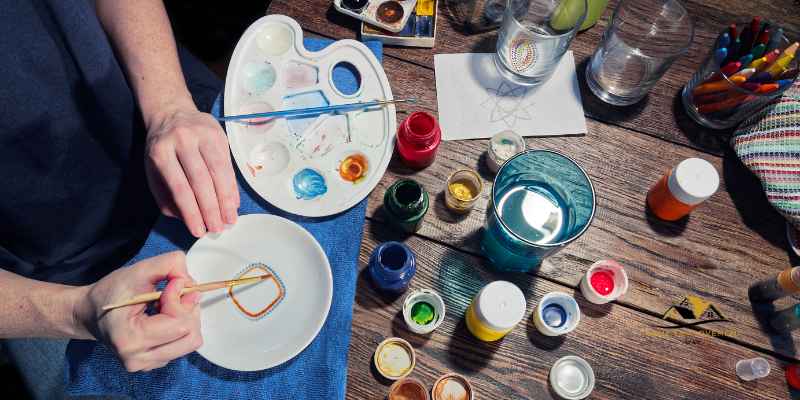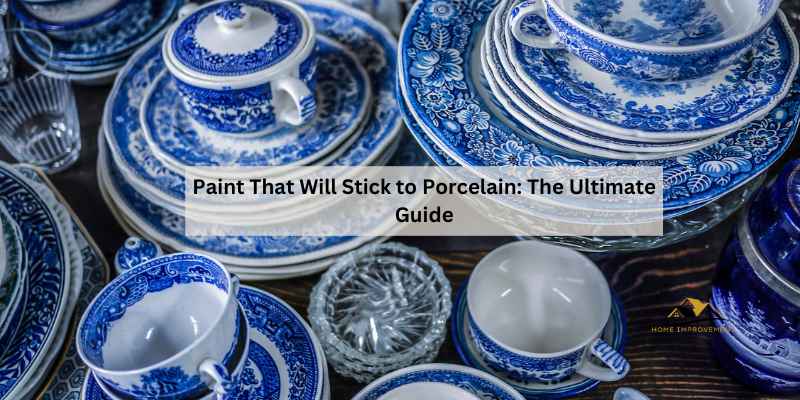When painting porcelain, use latex-based or epoxy products for best adhesion. Avoid oil-based or acrylic paint.
These paints can be applied using roll-on or spray-on methods, depending on your preference. Whether you’re painting a porcelain tub, sink, or toilet, using the right paint will ensure a lasting finish. Ceramic paint is ideal for longevity, while acrylic paint can provide vibrant colors but may not last as long.
By choosing the appropriate paint for your porcelain surfaces, you can achieve a durable and aesthetically pleasing result. Whether you’re embarking on a DIY project or seeking professional guidance, understanding the right paint for porcelain is essential for a successful outcome.
Latex-based Paints
Latex-based paints are a popular choice for painting porcelain due to their durability and versatility. These paints are water-based and offer a smooth, glossy finish when applied to porcelain surfaces. They are also known for their quick drying time, making them a convenient option for DIY projects and professional applications.
Advantages Of Using Latex-based Paints
- Easy application and clean-up
- Durable and long-lasting finish
- Resistant to moisture and humidity
- Wide range of color options available
- Compatible with various painting techniques
List Of Popular Latex-based Paints For Porcelain
| Product | Price | Retailer |
|---|---|---|
| White Can Interior, Exterior | $9.38 | Amazon.com |
| Watercolor Ruby Red | $42.98 | Home Depot |
| Black Spray Interior, Exterior | $39.96 | Amazon.com |
| White Can Interior, Exterior Satin Latex | $6.98 | Walmart |
| White Spray Interior, Exterior 12 oz | $7.98 | Lowe’s |
| Apple Red Can Exterior Semi-gloss | $6.98 | Walmart |
Epoxy Paints
Epoxy paints are a popular choice for painting porcelain due to their durability and adhesive properties. These specialized paints create a strong bond with the porcelain surface, ensuring long-lasting results.
Advantages Of Using Epoxy Paints
- Epoxy paints offer exceptional durability on porcelain surfaces.
- They provide resistance to chemicals and abrasions.
- These paints adhere well to smooth and slick surfaces like porcelain.
- Epoxy paints are water-resistant, making them ideal for porcelain applications.
List Of Popular Epoxy Paints For Porcelain
| Paint | Price |
|---|---|
| EZ-Poxy Modern Polyurethane Topside Paint, White, Quart by Pettit Paint | $69.99 |
| Universal All-Surface Spray Enamel Paint, White by Rust-Oleum | $18.99 |
| Specialty Tub and Tile Paint, High-Gloss White Tub Paint | $10.99 |
| White Can Interior, Exterior | $9.38 |
| Watercolor Ruby Red | $42.98 |
| Black Spray Interior, Exterior Flat | $39.96 |
Choose the right epoxy paint for your porcelain project to achieve a professional finish that will last for years to come.
Spray-on Paints
Spray-on paints are a convenient and effective way to add a fresh look to porcelain surfaces. These paints offer a smooth and even application, making them ideal for various porcelain items.
Advantages Of Using Spray-on Paints
- Easy to apply with a uniform finish
- Quick drying time for efficient painting
- Great coverage for a seamless look
- Available in a wide range of colors for customization
List Of Popular Spray-on Paints For Porcelain
| Paint | Price |
|---|---|
| EZ-Poxy Modern Polyurethane Topside Paint, White, Quart by Pettit Paint | $69.99 at West Marine |
| Universal All-Surface Spray Enamel Paint, White by Rust-Oleum | $18.99 at West Marine |
| Specialty Tub and Tile Paint, High-Gloss White Tub Paint for Bathtub | $10.99 on Amazon.com |
| White Can Interior, Exterior | $9.38 on Amazon.com |
| Watercolor Ruby Red | $42.98 at Home Depot |
For more options, consider these popular spray-on paints:
- Black Spray Interior, Exterior Flat – $39.96 on Amazon.com
- White Can Interior, Exterior Satin Latex – $6.98 at Walmart
- White Spray Oil Based – $18.99 at Ace Hardware
Preparation

Before painting porcelain, proper preparation is essential to ensure the paint adheres effectively. The following steps and materials are crucial for preparing porcelain for painting.
Steps To Prepare Porcelain For Painting
Preparation is key to achieving a lasting finish on porcelain. Follow these steps to ensure the surface is ready for painting:
- Clean the porcelain thoroughly using a mild detergent to remove any dirt, grease, or residues that may hinder paint adhesion.
- Use a fine-grit sandpaper to gently roughen the surface of the porcelain. This step helps the paint adhere better and promotes longevity.
- Wipe down the sanded surface with a damp cloth to remove any dust or debris, ensuring a clean and smooth base for the paint.
- Apply a primer specifically designed for porcelain surfaces. This will further enhance the adhesion of the paint and provide a suitable base for the topcoat.
- Allow the primer to dry completely according to the manufacturer’s instructions before proceeding with the painting process.
Materials Needed For Preparation
Preparing porcelain for painting requires the following materials:
| Materials | Description |
|---|---|
| Cleaner/Detergent | Mild detergent suitable for cleaning porcelain surfaces. |
| Fine-grit Sandpaper | To lightly roughen the porcelain surface for improved paint adhesion. |
| Damp Cloth | For wiping down the sanded surface to remove dust and debris. |
| Porcelain Primer | Specific primer designed for enhancing paint adhesion on porcelain. |
Application
For porcelain surfaces, opt for latex-based or epoxy paint over oil-based or acrylic options. Choose between roll-on or spray-on applications for a personalized finish. Upgrade your porcelain fixtures with the right paint for a durable and long-lasting result.
Steps To Apply Paint On Porcelain
When it comes to applying paint on porcelain, there are a few steps you need to follow to ensure a successful outcome. Here are the steps to follow:
- Clean the porcelain thoroughly with soap and water to remove any dirt, grime or oil that may affect the paint’s adhesion.
- Rinse the porcelain with water and let it dry completely.
- Apply a coat of primer specifically designed for porcelain. This will help the paint stick to the surface and prevent it from chipping or peeling off.
- Let the primer dry completely before applying the paint.
- Apply the paint in thin, even layers using a brush or spray can. Avoid applying too much paint at once as it may cause drips and unevenness. Let each layer dry before applying the next one.
- Once you have achieved the desired coverage, let the paint dry completely before using the porcelain object.
Tips For Achieving A Smooth Finish
To achieve a smooth and even finish when painting porcelain, here are a few tips to keep in mind:
- Use a high-quality paint specifically designed for porcelain.
- Apply the paint in thin, even layers to avoid drips and unevenness.
- Use a brush or spray can that is appropriate for the size of the object you are painting.
- Work in a well-ventilated area to avoid inhaling fumes from the paint.
- Let each layer of paint dry completely before applying the next one.
- Avoid using the porcelain object for at least 24 hours after painting to allow the paint to fully cure.
Remember to follow these steps and tips to ensure that your paint job on porcelain is successful and long-lasting.
Curing And Maintenance
Start of ‘Curing and Maintenance’ section
Importance Of Curing Painted Porcelain
Once you have painted your porcelain, it is essential to properly cure the paint to ensure its longevity and durability. Curing the paint helps to create a strong bond between the paint and the porcelain surface, making it more resistant to chipping, fading, and wear over time. Proper curing also enhances the overall appearance of the painted porcelain, giving it a smooth and glossy finish.
Tips For Maintaining Painted Porcelain
- Regular cleaning: Clean painted porcelain surfaces regularly with a mild detergent and water to remove any dirt or grime. Avoid using abrasive cleaners or scrubbing pads that can damage the painted surface.
- Gentle handling: Handle painted porcelain items with care to prevent accidental scratches or chips. Use soft cloths or padded storage to protect the painted surface from abrasion.
- Avoid harsh chemicals: Refrain from using harsh chemicals or solvents on painted porcelain, as they can degrade the paint and affect its adhesion to the surface.
- Protect from heat: Protect painted porcelain from extreme heat, as high temperatures can cause the paint to blister or discolor. Use coasters or trivets to shield painted surfaces from hot objects.
- Touch-up when needed: If any chips or scratches occur, promptly touch up the affected areas with matching porcelain paint to maintain the integrity of the painted surface.
End of ‘Curing and Maintenance’ section

Frequently Asked Questions
What Kind Of Paint Will Stick To Porcelain?
Latex-based and epoxy paint are best for porcelain, avoiding oil-based or acrylic options. Choose roll-on or spray-on paint based on preference for long-lasting results.
What Paint Will Stay On Porcelain?
Latex-based and epoxy paints are suitable for porcelain, while oil-based and acrylic paints are not recommended. You can choose between roll-on or spray-on paint based on your preference. Consider using ceramic paint for longer-lasting results due to its hardening additive.
What Paint Will Cover Porcelain?
For porcelain, use latex-based or epoxy paint, not oil-based or acrylic. You can choose roll-on or spray-on paint based on your preference. Ceramic paint is also suitable for longer-lasting results. Avoid oil-based or acrylic paint for porcelain surfaces.
Do You Need Special Paint For Porcelain?
For porcelain, use latex-based or epoxy paint, not oil-based or acrylic. Choose roll-on or spray-on based on preference. Ceramic paint ensures longer durability compared to acrylic for brighter colors.
Conclusion
When painting porcelain, choose latex or epoxy for lasting results. Ceramic paint is also a good option for durability. Ensure your paint choice adheres well to porcelain surfaces for a lasting finish. Explore different options to find the best paint for your project.
Happy painting!


